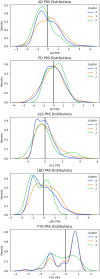Genetic risk factor clustering within and across neurodegenerative diseases
- PMID: 37192343
- PMCID: PMC10629980
- DOI: 10.1093/brain/awad161
Genetic risk factor clustering within and across neurodegenerative diseases
Abstract
Overlapping symptoms and co-pathologies are common in closely related neurodegenerative diseases (NDDs). Investigating genetic risk variants across these NDDs can give further insight into disease manifestations. In this study we have leveraged genome-wide single nucleotide polymorphisms and genome-wide association study summary statistics to cluster patients based on their genetic status across identified risk variants for five NDDs (Alzheimer's disease, Parkinson's disease, amyotrophic lateral sclerosis, Lewy body dementia and frontotemporal dementia). The multi-disease and disease-specific clustering results presented here provide evidence that NDDs have more overlapping genetic aetiology than previously expected and how neurodegeneration should be viewed as a spectrum of symptomology. These clustering analyses also show potential subsets of patients with these diseases that are significantly depleted for any known common genetic risk factors suggesting environmental or other factors at work. Establishing that NDDs with overlapping pathologies share genetic risk loci, future research into how these variants might have different effects on downstream protein expression, pathology and NDD manifestation in general is important for refining and treating NDDs.
Keywords: dementia; genome-wide association study; machine learning; single-nucleotide polymorphism; unsupervised.
© The Author(s) 2023. Published by Oxford University Press on behalf of the Guarantors of Brain.
Conflict of interest statement
C.A., K.L., H.L., H.I., D.V., F.F. and M.N.’s participation in this project was part of a competitive contract awarded to Data Tecnica International LLC by the National Institutes of Health to support open science research. M.N. also currently serves on the scientific advisory board for Clover Therapeutics and is an advisor to Neuron23 Inc.
Figures


Comment in
-
Exploring shared features in neurodegenerative diseases.Brain. 2023 Nov 2;146(11):4405-4407. doi: 10.1093/brain/awad337. Brain. 2023. PMID: 37791588 No abstract available.
References
-
- Uffelmann E, Huang QQ, Munung NS, et al. Genome-wide association studies. Nature Reviews Methods Primers. 2021;1:1–21.
Publication types
MeSH terms
Grants and funding
- P30 AG072975/AG/NIA NIH HHS/United States
- U01 AG046152/AG/NIA NIH HHS/United States
- RF1 AG057440/AG/NIA NIH HHS/United States
- P50 AG016574/AG/NIA NIH HHS/United States
- U01 AG061356/AG/NIA NIH HHS/United States
- R01 AG017917/AG/NIA NIH HHS/United States
- P30 AG010161/AG/NIA NIH HHS/United States
- R01 AG032990/AG/NIA NIH HHS/United States
- R01 NS080820/NS/NINDS NIH HHS/United States
- U01 AG046139/AG/NIA NIH HHS/United States
- P01 AG017216/AG/NIA NIH HHS/United States
- R01 AG018023/AG/NIA NIH HHS/United States
- U01 AG046170/AG/NIA NIH HHS/United States
- U24 AG061340/AG/NIA NIH HHS/United States
- P01 AG003949/AG/NIA NIH HHS/United States
- U24 NS072026/NS/NINDS NIH HHS/United States
- P30 AG019610/AG/NIA NIH HHS/United States
- P50 AG025711/AG/NIA NIH HHS/United States
- U01 AG006786/AG/NIA NIH HHS/United States
- R01 AG036836/AG/NIA NIH HHS/United States
- R01 AG015819/AG/NIA NIH HHS/United States
- ZIA NS003154/ImNIH/Intramural NIH HHS/United States

